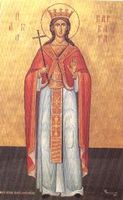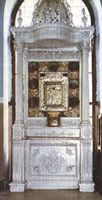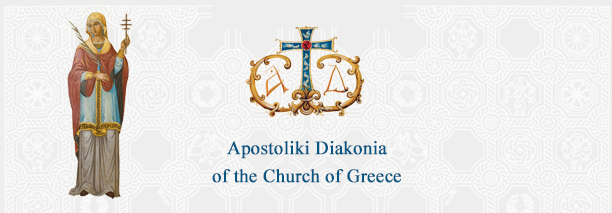 As of the 20 th April 1949, under Law No.957, the holy shrine of St. Barbara in the Egaleo district of the St. Barbara Municipality is under the ownership, jurisdiction and administration of the Apostolic Diakonia of the Church of Greece. Proceeds from this holy shrine are always donated to various missionary and social needs. As of the 20 th April 1949, under Law No.957, the holy shrine of St. Barbara in the Egaleo district of the St. Barbara Municipality is under the ownership, jurisdiction and administration of the Apostolic Diakonia of the Church of Greece. Proceeds from this holy shrine are always donated to various missionary and social needs.
THE PILGRIMAGE TEMPLE
The Temple as we see it today was built in 1904, and its architectural rhythm is that of a three-naved basilica. The central nave honors the name of Saint Barbara. The right-hand nave is dedicated to the Glorious, latter-day Martyr Fanourios, while the left-hand nave is dedicated to Saint Mavra. Both these chapels were consecrated by the late Metropolitan of Athens, Theokletos I.
The Holy Sanctuary of the Temple is also named DISCOVERY, «EVRESIS», as it denotes the exact spot where the miraculous icon of St. Barbara was discovered. We have no historical information on the year in which the first Temple was erected; it is said, that it was the remnant of an older Monastery that was dissolved and destroyed. The only authentic historical information that we have on the existence of a Temple is the year «1774» that is clearly inscribed on the mural icon of St Barbara, inside the Holy Sanctuary.
We have assumed the existence of a Temple prior to the year 1774, given that the hagiography of mural icons is not usually concurrent to the actual building of the edifice. Unwritten tradition that has been preserved by Christians to this day, maintains the existence of a Temple in this area for over 1000 years; this would make it almost as old as the neighbouring Monastery of Daphni.
The tiny church that existed in the location that the present Church now stands was practically lost, on account of its abandonment for so many years. It had been buried under 80 cm of earth and stones, and was being used as a sheep pen. This conclusion was reached, by observing the extent of the damages to the murals. This also explains the differing depth of the central nave of the present Temple.
 THE DISCOVERY OF THE HOLY ICON THE DISCOVERY OF THE HOLY ICON
How and when was the icon of St. Barbara discovered? In a wondrous way. About 100 years ago, a shepherd had been using the little church as a pen for his sheep. One night, he saw a young woman in his dream, who said to him: «This place that you are using as shelter for your sheep is mine, and you must stop desecrating it». The shepherd paid no attention to the dream, and did nothing about it. After several days had gone by, he started to lose one sheep each day. The young woman then re-appeared in his dream, and said to him «Tomorrow, two people will come to this place. You will accost them, and ask them to dig the ground on the right-hand side of the entrance». Indeed, the next day two women - Marigo Koula and Angelica K. Tsambazi - came from Piraeus to that place to gather herbs. These were the women for whom was reserved the great blessing of discovering the miraculous icon of St. Barbara; an icon measuring 37 x 26 cm., which to this day is guarded within the Shrine and is acknowledged as a holy relic and a boast for every Christian.
News of this event spread throughout Greece, and from that day hence, the faithful swarm to this saint's grace, to pray and to ask for her embassies and her intervention.
A large volume would be hardly enough space, to record the miracles and signs that the pious faithful have preserved, during the 200 or so years of this Shrine, not to mention the innumerable dedications and offerings that are daily brought here by pilgrims, with faith, reverence and a eucharist disposition.
Today, with the permission of the Technical Services of the Church of Greece, the supervision of the Archaeological Society and the excellent collaboration between our Church and the archaeologists, the restoration and renovation work on the holy Temple has commenced, along with the maintenance of the exquisitely carved woodwork and the murals - many of which have been narrated by the renowned hagiographer Fotis Kontoglou - as well as the landscaping of the surrounding area of the Temple. The cost of this project has been estimated to reach 350 million drachmas, and is to be borne by the Apostolic Diakonia of the Church of Greece. The work is progressing well, with the help of God, the grace of the saint, and the love of our Christians.
Address: 40, El. Venizelou str, P.C. 123 51 - AGIA VARVARA, ATTICA
Church Super: The Very Revd. Archimandrite Damaskinos Damianakis.
The Rvd: Nikolaos Gasevich, Anastasios Sonidis.
Stuff : Eleftheria Petaniti, Nektaria Kapola.
Choral
: Nikolaos Gourlas.
(tel. +30 210 5612226, fax +30 210 545 0070)
|
